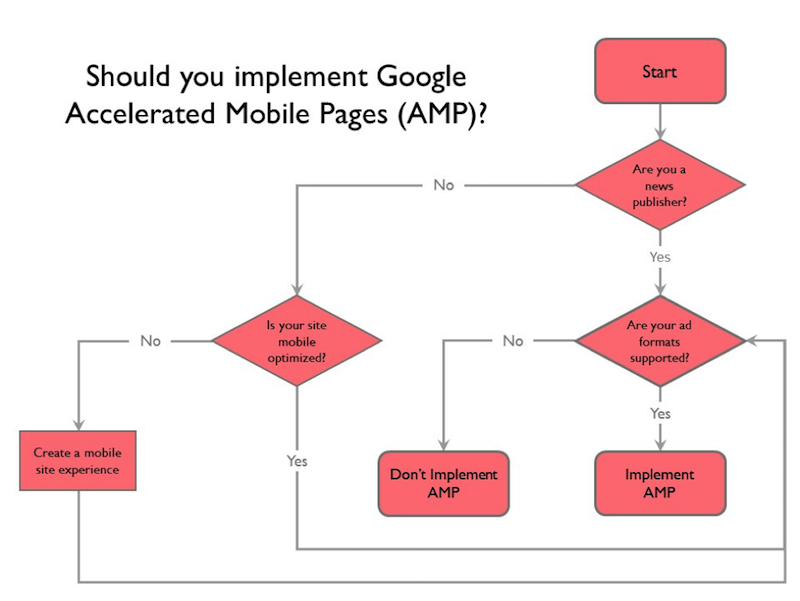Google continues to shake up mobile search in its goal to perfect user experience. Earlier this month, they announced that they will extend the reach of Accelerated Mobile Pages (AMP) to all mobile search engine results.
Whereas the original rollout limited AMP results to the “Top Stories” carousel, this update will allow all types of publishers to serve AMP pages within the mobile SERP.
However, this extension will not have as much of an impact on organic traffic. Google has explicitly stated that moving to AMP will not necessarily result in a rankings boost. Instead, if a webpage is ranking and has an AMP version available, Google will serve the AMP URL.
Recap: what is AMP?
AMP is an open-source initiative meant to create a more streamlined mobile user experience by reducing page size and load times. I previously speculated about AMP’s potential impact on publishers when Google announced the original February 2016 rollout.
Since then, AMP adoption has been wide. The AMP Project website lists close to 300 big-name brands using the framework, and Google estimates that there are 4 million new pages being indexed every week.
With this latest change, we can expect to see adoption increase precipitously.
Who will benefit from implementing AMP?
Of course, this raises the question of which sites will benefit the most from AMP.
According to Google’s Washington Post case study, there was a 23% increase in return visitors with AMP. It stands to reason that if a large percentage of your site’s traffic comes from mobile users and you’re constantly churning out content, then AMP makes sense, as the shorter load times mean higher content consumption rates. Not to mention that the one-time implementation of the AMP framework will affect an exponential number of pages as time goes on.

A simple flow chart to determine if your brand should implement Google AMP
Who shouldn’t implement AMP?
It’s also worth noting that AMP is not without its detractors.
Based on anecdotal data, AMP Top Stories may actually result in lower CTR from the SERP. So it’s likely that the AMP icon next to traditional search results will also not have a significant impact on CTR.
And if the bulk of your site revenue stems from ad formats or partnerships that aren’t AMP-compatible, then AMP may not be right for you either.
Furthermore, if your brand doesn’t have a mobile-optimized site (whether responsive, subdomain/subdirectory, etc.), then AMP is not a band-aid. In these cases, your site is already at a disadvantage in mobile search, since mobile-friendliness has officially been a ranking factor since April’s community-dubbed “Mobilegeddon” update.
Therefore, if your site doesn’t already show up as mobile-friendly, having an AMP version (paradoxically) does not count as a mobile site and will not improve your organic visibility.
The better use of development resources would be to create a mobile-friendly version of your site, as mobile users can also reach your content in a variety of other ways (direct traffic, referrals, other search engines, etc.).
If your mobile experience is rooted in using an app, then app indexation is a much better route than AMP. This includes app-first experiences (like Uber) or sites with extensive security features that are not easily accessible in browsers (like bank apps).
Last but not least, it’s no coincidence that AMP encourages users to stay within Google’s ecosystem (if the persistent blue “back” bar is any indication). If your business relies on seamless multiple-page sessions, AMP is likely not the best experience for that, as it limits top level navigation and links open in new browser windows.

Clicking a Top Stories carousel link loads an AMP page with the option to swipe for more related AMP-formatted content (see the persistent AMP bar at top with carousel indicator dots)

Clicking an AMP results from the standard mobile SERP will open a stripped down version of the page with fewer navigational options, and a persistent blue bar with a call-to-action that brings users back to their Google search
Future considerations
There are a lot of big ifs in Google’s roadmap for AMP, many of them outside of Google’s control.
If AMP sees wider adoption, then we’ll likely see more ad technologies adopt to be AMP-friendly. And if certain content formats receive good engagement, then Google may roll out standardized best practices for displaying that content (like they did with microformats).
Lastly, Google may also roll out AMP to support Ecommerce functionality as well. Back in June, eBay became a self-appointed guinea pig, creating AMP versions of their product listing pages (but not the auction pages themselves).
It was a proof-of-concept that shop sites could use AMP for mid-funnel content, and a potential argument for Google to extend functionality to pages with transactional functionalities as well.
Of course, the checkout process would be a big hurdle to overcome, much like ad formats. Perhaps linking from AMP listing pages to deep-linked app product pages could be a viable strategy.
Takeaways
If your site is already mobile-friendly, and you want to encourage content consumption, AMP may be right for you. When AMP is available for non-news publishers, we’ll likely get more case studies from Google about user interaction behaviors.
However, if you want to get ahead of the curve, Google has provided documentation and it’s straightforward enough to implement AMP.
Kenny Chung is the Manager, SEO, DigitasLBi and a contributor to SEW.


